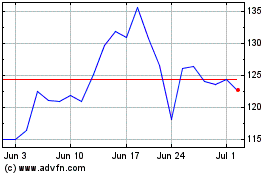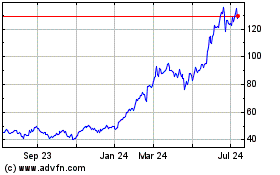NVIDIA and HP Supercharge Data Science and Generative AI on Workstations
March 07 2024 - 11:55AM

HP Amplify — NVIDIA and HP Inc. today announced that NVIDIA CUDA-X™
data processing libraries will be integrated with HP AI workstation
solutions to turbocharge the data preparation and processing work
that forms the foundation of generative AI development.
Built on the NVIDIA CUDA® compute platform, CUDA-X libraries
speed data processing for a broad range of data types, including
tables, text, images and video. They include the NVIDIA RAPIDS™
cuDF library, which accelerates the work of the nearly 10 million
data scientists using pandas software by up to 110x using an NVIDIA
RTX™ 6000 Ada Generation GPU instead of a CPU-only system, without
requiring any code changes.
RAPIDS cuDF and other NVIDIA software will be available as part
of Z by HP AI Studio on HP AI workstations to provide a full-stack
development solution that speeds data science workflows.
“Pandas is the essential tool of millions of data scientists
processing and preparing data for generative AI,” said Jensen
Huang, founder and CEO at NVIDIA. “Accelerating pandas with zero
code changes will be a massive step forward. Data scientists can
process data in minutes rather than hours, and wrangle orders of
magnitude more data to train generative AI models.”
“Data science provides the foundation for AI, and developers
need fast access to software and systems to power this critical
work,” said Enrique Lores, president and CEO of HP Inc. “With the
integration of NVIDIA AI software and accelerated GPU compute, HP
AI workstations provide a powerful solution for our customers.”
NVIDIA CUDA-X Speeds Data Science on HP Workstation
SolutionsPandas provides a powerful data structure, called
DataFrames, which lets developers easily manipulate, clean and
analyze tabular data.
The NVIDIA RAPIDS cuDF library accelerates pandas so that it can
run on GPUs with zero code changes, rather than relying on CPUs,
which can slow workloads as data size grows. RAPIDS cuDF is
compatible with third-party libraries and unifies GPU and CPU
workflows so data scientists can develop, test and run models in
production seamlessly.
As datasets continue to grow, RTX 6000 Ada Generation GPUs
provide 48GB of memory per GPU to process large data science and AI
workloads on Z by HP workstations. With up to four RTX 6000 GPUs,
the HP Z8 Fury is one of the world’s most powerful workstations for
AI creation. The close collaboration between HP and NVIDIA allows
data scientists to streamline development by working on local
systems to process even large generative AI workloads.
AvailabilityNVIDIA RAPIDS cuDF for accelerated
pandas with zero code changes is expected to be available on HP AI
workstation solutions with NVIDIA RTX and GeForce RTX GPUs this
month and on HP AI Studio later this year.
About NVIDIASince its founding in 1993, NVIDIA
(NASDAQ: NVDA) has been a pioneer in accelerated computing. The
company’s invention of the GPU in 1999 sparked the growth of the PC
gaming market, redefined computer graphics, ignited the era of
modern AI and is fueling industrial digitalization across markets.
NVIDIA is now a full-stack computing infrastructure company with
data-center-scale offerings that are reshaping industry. More
information at https://nvidianews.nvidia.com/.
For further information, contact:Shannon
McPheeNVIDIA Corporationsmcphee@nvidia.com+1-310-920-9642
Certain statements in this press release including, but not
limited to, statements as to: the benefits, impact, and performance
of NVIDIA’s products, services, and technologies, including NVIDIA
CUDA-X data processing libraries, NVIDIA CUDA, NVIDIA RAPIDS cuDF,
NVIDIA RTX 6000 Ada Generation GPU and NVIDIA RTX and GeForce RTX
GPUs; the benefits and impact of NVIDIA’s collaboration with HP
Inc., and the features and availability of its services and
offerings; pandas being the essential tool of millions of data
scientists processing and preparing data for generative AI;
accelerating pandas with zero code changes being a massive step
forward; and the ability of data scientists to process data in
minutes rather than hours, and wrangle orders of magnitude more
data to train generative AI models are forward-looking statements
that are subject to risks and uncertainties that could cause
results to be materially different than expectations. Important
factors that could cause actual results to differ materially
include: global economic conditions; our reliance on third parties
to manufacture, assemble, package and test our products; the impact
of technological development and competition; development of new
products and technologies or enhancements to our existing product
and technologies; market acceptance of our products or our
partners' products; design, manufacturing or software defects;
changes in consumer preferences or demands; changes in industry
standards and interfaces; unexpected loss of performance of our
products or technologies when integrated into systems; as well as
other factors detailed from time to time in the most recent reports
NVIDIA files with the Securities and Exchange Commission, or SEC,
including, but not limited to, its annual report on Form 10-K and
quarterly reports on Form 10-Q. Copies of reports filed with the
SEC are posted on the company's website and are available from
NVIDIA without charge. These forward-looking statements are not
guarantees of future performance and speak only as of the date
hereof, and, except as required by law, NVIDIA disclaims any
obligation to update these forward-looking statements to reflect
future events or circumstances.
© 2024 NVIDIA Corporation. All rights reserved. NVIDIA, the
NVIDIA logo, CUDA-X, CUDA and NVIDIA RTX are trademarks and/or
registered trademarks of NVIDIA Corporation in the U.S. and other
countries. Other company and product names may be trademarks of the
respective companies with which they are associated. Features,
pricing, availability and specifications are subject to change
without notice.
NVIDIA (NASDAQ:NVDA)
Historical Stock Chart
From Mar 2024 to Apr 2024

NVIDIA (NASDAQ:NVDA)
Historical Stock Chart
From Apr 2023 to Apr 2024
